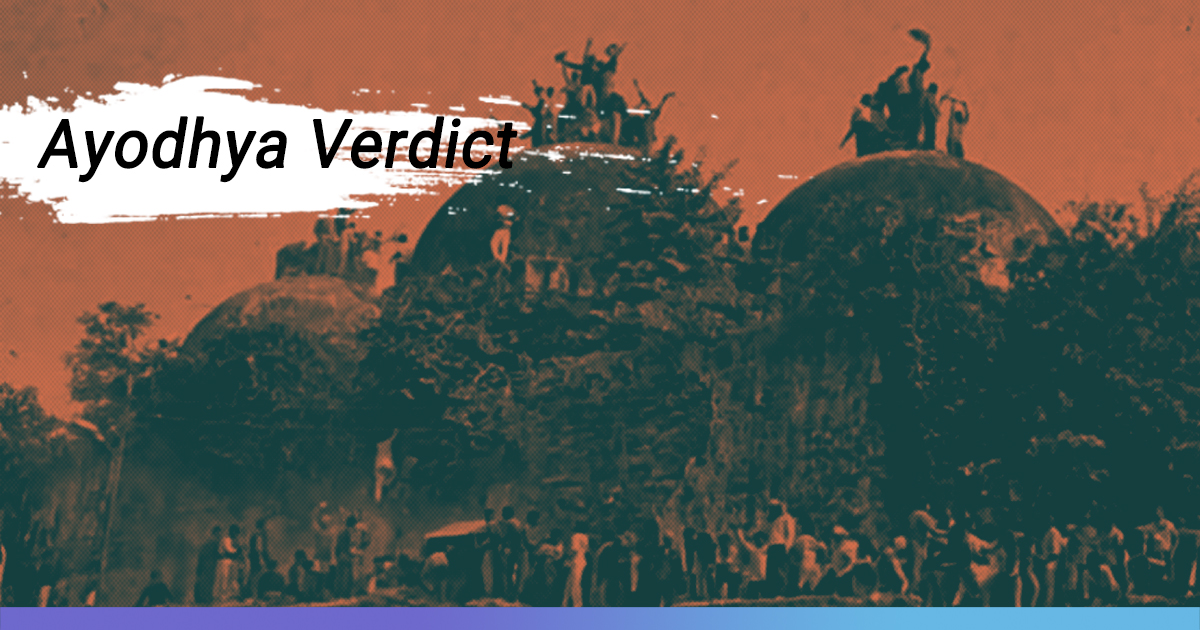
Read: Full-Text Of The Supreme Court Verdict On Ayodhya Land Dispute
9 Nov 2019 10:15 AM GMT
Here is the full-text version of the final verdict of the Supreme Court on the disputed land of Ayodhya.
Conclusion of title
The facts, evidence and oral arguments of the present case have traversed the realms of history, archaeology, religion and the law. The law must stand apart from political contestations over history, ideology and religion.
For a case replete with references to archaeological foundations, we must remember that it is the law which provides the edifice upon which our multicultural society rests. The law forms the ground upon which, multiple strands of history, ideology and religion can compete. By determining their limits, this Court as the final arbiter must preserve the sense of balance that the beliefs of one citizen do not interfere with or dominate the freedoms and beliefs of another.
On 15 August 1947, India as a nation realised the vision of self-determination. On 26 January 1950, we gave ourselves the Constitution of India, as an unwavering commitment to the values which define our society.
The Constitution does not make a distinction between the faith and belief of one religion and another. All forms of belief, worship and prayer are equal. Those whose duty it is to interpret the Constitution, enforce it and engage with it can ignore this only to the peril of our society and nation. The Constitution speaks to the judges who interpret it, to those who govern who must enforce it, but above all, to the citizens who engage with it as an inseparable feature of their lives.
In the present case, this Court is tasked with an adjudicatory task of the unique dimension. The dispute is over immovable property. The court does not decide the title on the basis of faith or belief but on the basis of evidence. The law provides us with parameters as clear but as profound as ownership and possession. In deciding title to the disputed property, the court applies settled principles of evidence to adjudicate upon which party has established a claim to the immovable property.
As regards the inner courtyard, there is evidence on a preponderance of probabilities to establish worship by the Hindus prior to the annexation of Oudh by the British in 1857. The Muslims have offered no evidence to indicate that they were in exclusive possession of the inner structure prior to 1857 since the date of the construction in the sixteenth century.
After the setting up of the grill-brick wall, the structure of the mosque continued to exist and there is evidence to indicate that namaz was offered within its precincts. The report of the Waqf Inspector of December 1949 indicates that Muslims were being obstructed in free and unimpeded access to the mosque for the purposes of offering namaz.
However, there is evidence to show that namaz was offered in the structure of the mosque and the last Friday namaz was on 16 December 1949. The exclusion of the Muslims from worship and possession took place on an intervening night between 22/23 December 1949 when the mosque was desecrated by the installation of Hindu idols. The ouster of the Muslims on that occasion was not through any lawful authority but through an act which was calculated to deprive them of their place of worship.
After the proceedings under Section 145 of CrPC 1898 were initiated and a receiver was appointed following the attachment of the inner courtyard, worship of the Hindu idols was permitted. During the pendency of the suits, the entire structure of the mosque was brought down in a calculated act of destroying a place of public worship. The Muslims have been wrongly deprived of a mosque which had been constructed well over 450 years ago.
We have already concluded that the three-way bifurcation by the High Court was legally unsustainable. Even as a matter of maintaining public peace and tranquillity, the solution which commended itself to the High Court is not feasible. The disputed site admeasures all of 1500 square yards. Dividing the land will not subserve the interest of either of the parties or secure a lasting sense of peace and tranquillity.
Suit 5 has been held to be maintainable at the behest of the first plaintiff (the deity of Lord Ram) who is a juristic person. The third plaintiff (next friend) has been held to be entitled to represent the first plaintiff. We are of the view that on the one hand, a decree must ensue in Suit 5, Suit 4 must also be partly decreed by directing the allotment of alternate land to the Muslims for the construction of a mosque and associated activities.
The allotment of land to the Muslims is necessary because though on a balance of probabilities, the evidence in respect of the possessory claim of the Hindus to the composite whole of the disputed property stands on a better footing than the evidence adduced by the Muslims, the Muslims were dispossessed upon the desecration of the mosque on 22/23 December 1949 which was ultimately destroyed on 6 December 1992.
There was no abandonment of the mosque by the Muslims. This Court in the exercise of its powers under Article 142 of the Constitution must ensure that a wrong committed must be remedied. Justice would not prevail if the Court were to overlook the entitlement of the Muslims who have been deprived of the structure of the mosque through means which should not have been employed in a secular nation committed to the rule of law. The Constitution postulates the equality of all faiths. Tolerance and mutual co-existence nourish the secular commitment of our nation and its people.
The area of the composite site admeasures about 1500 square yards.
While determining the area of land to be allotted, it is necessary to provide restitution to the Muslim community for the unlawful destruction of their place of worship. Having weighed the nature of the relief which should be granted to the Muslims, we direct that land admeasuring 5 acres be allotted to the Sunni Central Waqf Board either by the Central Government out of the acquired land or by the Government of Uttar Pradesh within the city of Ayodhya.
This exercise, and the consequent handing over of the land to the Sunni Central Waqf Board, shall be conducted simultaneously with the handing over of the disputed site comprising of the inner and outer courtyards as a consequence of the decree in Suit 5. Suit 4 shall stand decreed in the above terms.
Section 6 of the Acquisition of Certain Area at Ayodhya Act 1993 empowers the Central Government to direct that the right, title and interest in relation to the area or any part thereof, instead of continuing to vest in the Central Government shall vest in the authority or body or trustees of any trust which is willing to comply with the terms and conditions as government may impose.407 Section 7(1) provides that the property vested in the Central Government under Section 3, shall be maintained by the government or by any person or trustees of any trust, authorities in this behalf.
We are of the view that it would be necessary to direct the Central Government to frame a scheme in the exercise of the powers conferred upon it by Sections 6 and 7 to set up a trust or any other appropriate mechanism to whom the land would be handed over in terms of the decree in Suit 5. The scheme shall incorporate all provisions necessary to vest power and authority in relation to the management of the trust or the body chosen for the vesting of the land.
Reliefs And Directions
We accordingly order and direct as follows:
1 (i) Suit 3 instituted by Nirmohi Akhara is held to be barred by limitation and shall accordingly stand dismissed;
(ii) Suit 4 instituted by the Sunni Central Waqf Board and other plaintiffs is held to be within limitation. The judgment of the High Court holding Suit 4 to be barred by limitation is reversed; and’
(iii) Suit 5 is held to be within limitation.
2 Suit 5 is held to be maintainable at the behest of the first plaintiff who is represented by the third plaintiff. There shall be a decree in terms of prayer clauses (A) and (B) of the suit, subject to the following directions:
(i) The Central Government shall, within a period of three months from the date of this judgment, formulate a scheme pursuant to the powers vested in it under Sections 6 and 7 of the Acquisition of Certain Area at Ayodhya Act 1993. The scheme shall envisage the setting up of trust with a Board of Trustees or any other appropriate body under Section 6. The scheme to be framed by the Central Government shall make necessary provisions in regard to the functioning of the trust or body including on matters relating to the management of the trust, the powers of the trustees including the construction of a temple and all necessary, incidental and supplemental matters;
(ii) Possession of the inner and outer courtyards shall be handed over to the Board of Trustees of the Trust or to the body so constituted. The Central Government will be at liberty to make suitable provisions in respect of the rest of the acquired land by handing it over to the Trust or body for management and development in terms of the scheme framed in accordance with the above directions; and
(iii) Possession of the disputed property shall continue to vest in the statutory receiver under the Central Government, until in exercise of its jurisdiction under Section 6 of the Ayodhya Act of 1993, a notification is issued vesting the property in the trust or other bodies.
3 (i) Simultaneously, with the handing over of the disputed property to the Trust or body under clause 2 above, a suitable plot of land admeasuring 5 acres shall be handed over to the Sunni Central Waqf Board, the plaintiff in Suit
4.
(ii) The land shall be allotted either by:
(a) The Central Government out of the land acquired under the Ayodhya
Act 1993; or
(b) The State Government at a suitably prominent place in Ayodhya;
The Central Government and the State Government shall act in consultation with each other to effectuate the above allotment in the period stipulated.
(iii) The Sunni Central Waqf Board would be at liberty, on the allotment of the land to take all necessary steps for the construction of a mosque on the land so allotted together with other associated facilities;
(iv) Suit 4 shall stand decreed to this extent in terms of the above directions; and
(v) The directions for the allotment of land to the Sunni Central Waqf Board in Suit 4 are issued in pursuance of the powers vested in this Court under Article 142 of the Constitution.
4 In exercise of the powers vested in this Court under Article 142 of the Constitution, we direct that in the scheme to be framed by the Central Government, an appropriate representation may be given in the Trust or body, to the Nirmohi Akhara in such manner as the Central Government deems fit.
5 The right of the plaintiff in Suit 1 to worship at the disputed property is affirmed subject to any restrictions imposed by the relevant authorities with respect to the maintenance of peace and order and the performance of orderly worship.
All the appeals shall stand disposed of in the above terms. Parties are left to bear their own costs.
Also Read: Hindi Touted To Be New Official Language Of J&K, Kashmiris Call It Imposition
 All section
All section













